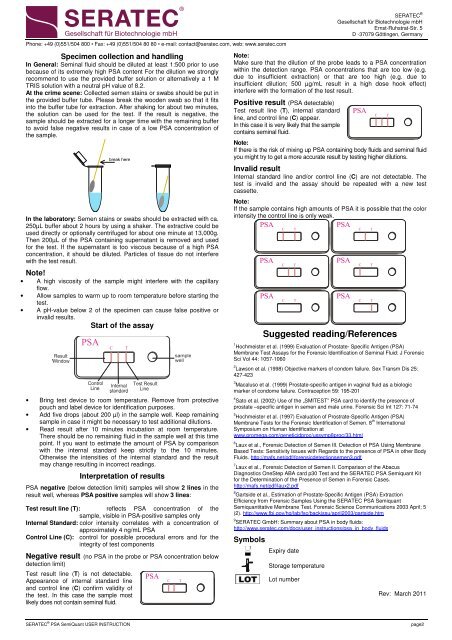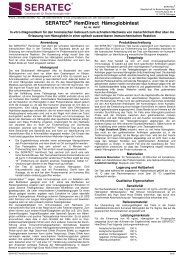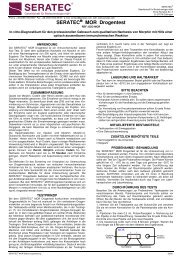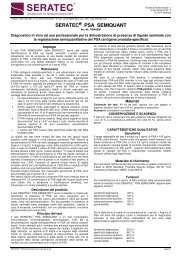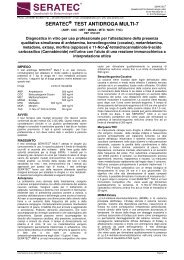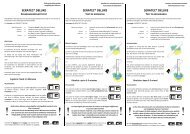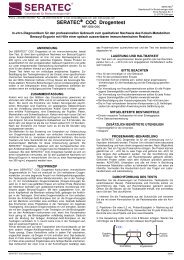SERATEC® PSA CRIME SCENE BOX
SERATEC® PSA CRIME SCENE BOX
SERATEC® PSA CRIME SCENE BOX
You also want an ePaper? Increase the reach of your titles
YUMPU automatically turns print PDFs into web optimized ePapers that Google loves.
Phone: +49 (0)551/504 800 • Fax: +49 (0)551/504 80 80 • e-mail: contact@seratec.com, web: www.seratec.com<br />
Specimen collection and handling<br />
In General: Seminal fluid should be diluted at least 1:500 prior to use<br />
because of its extremely high <strong>PSA</strong> content For the dilution we strongly<br />
recommend to use the provided buffer solution or alternatively a 1 M<br />
TRIS solution with a neutral pH value of 8.2.<br />
At the crime scene: Collected semen stains or swabs should be put in<br />
the provided buffer tube. Please break the wooden swab so that it fits<br />
into the buffer tube for extraction. After shaking for about two minutes,<br />
the solution can be used for the test. If the result is negative, the<br />
sample should be extracted for a longer time with the remaining buffer<br />
to avoid false negative results in case of a low <strong>PSA</strong> concentration of<br />
the sample.<br />
In the laboratory: Semen stains or swabs should be extracted with ca.<br />
250µL buffer about 2 hours by using a shaker. The extractive could be<br />
used directly or optionally centrifuged for about one minute at 13,000g.<br />
Then 200µL of the <strong>PSA</strong> containing supernatant is removed and used<br />
for the test. If the supernatant is too viscous because of a high <strong>PSA</strong><br />
concentration, it should be diluted. Particles of tissue do not interfere<br />
with the test result.<br />
Note!<br />
• A high viscosity of the sample might interfere with the capillary<br />
flow.<br />
• Allow samples to warm up to room temperature before starting the<br />
test.<br />
• A pH-value below 2 of the specimen can cause false positive or<br />
invalid results.<br />
Start of the assay<br />
• Bring test device to room temperature. Remove from protective<br />
pouch and label device for identification purposes.<br />
• Add five drops (about 200 µl) in the sample well. Keep remaining<br />
sample in case it might be necessary to test additional dilutions.<br />
• Read result after 10 minutes incubation at room temperature.<br />
There should be no remaining fluid in the sample well at this time<br />
point. If you want to estimate the amount of <strong>PSA</strong> by comparison<br />
with the internal standard keep strictly to the 10 minutes.<br />
Otherwise the intensities of the internal standard and the result<br />
may change resulting in incorrect readings.<br />
Interpretation of results<br />
<strong>PSA</strong> negative (below detection limit) samples will show 2 lines in the<br />
result well, whereas <strong>PSA</strong> positive samples will show 3 lines:<br />
Test result line (T): reflects <strong>PSA</strong> concentration of the<br />
sample, visible in <strong>PSA</strong>-positive samples only<br />
Internal Standard: color intensity correlates with a concentration of<br />
approximately 4 ng/mL <strong>PSA</strong><br />
Control Line (C): control for possible procedural errors and for the<br />
integrity of test components<br />
Negative result (no <strong>PSA</strong> in the probe or <strong>PSA</strong> concentration below<br />
detection limit)<br />
Test result line (T) is not detectable.<br />
Appearance of internal standard line<br />
and control line (C) confirm validity of<br />
the test. In this case the sample most<br />
likely does not contain seminal fluid.<br />
SERATEC ®<br />
Gesellschaft für Biotechnologie mbH<br />
Ernst-Ruhstrat-Str. 5<br />
D -37079 Göttingen, Germany<br />
Note:<br />
Make sure that the dilution of the probe leads to a <strong>PSA</strong> concentration<br />
within the detection range. <strong>PSA</strong> concentrations that are too low (e.g.<br />
due to insufficient extraction) or that are too high (e.g. due to<br />
insufficient dilution; 500 µg/mL result in a high dose hook effect)<br />
interfere with the formation of the test result.<br />
Positive result (<strong>PSA</strong> detectable)<br />
Test result line (T), internal standard<br />
line, and control line (C) appear.<br />
In this case it is very likely that the sample<br />
contains seminal fluid.<br />
Note:<br />
If there is the risk of mixing up <strong>PSA</strong> containing body fluids and seminal fluid<br />
you might try to get a more accurate result by testing higher dilutions.<br />
Invalid result<br />
Internal standard line and/or control line (C) are not detectable. The<br />
test is invalid and the assay should be repeated with a new test<br />
cassette.<br />
Note:<br />
If the sample contains high amounts of <strong>PSA</strong> it is possible that the color<br />
intensity the control line is only weak.<br />
Suggested reading/References<br />
1 Hochmeister et al. (1999) Evaluation of Prostate- Specific Antigen (<strong>PSA</strong>)<br />
Membrane Test Assays for the Forensic Identification of Seminal Fluid: J Forensic<br />
Sci Vol 44: 1057-1060<br />
2 Lawson et al. (1998) Objective markers of condom failure. Sex Transm Dis 25:<br />
SERATEC ® <strong>PSA</strong> SemiQuant USER INSTRUCTION page2<br />
427-423<br />
3 Macaluso et al. (1999) Prostate-specific antigen in vaginal fluid as a biologic<br />
marker of condome failure. Contraception 59: 195-201<br />
4 Sato et al. (2002) Use of the „SMITEST” <strong>PSA</strong> card to identify the presence of<br />
prostate –specific antigen in semen and male urine. Forensic Sci Int 127: 71-74<br />
5 Hochmeister et al. (1997) Evaluation of Prostrate-Specific Antigen (<strong>PSA</strong>)<br />
Membrane Tests for the Forensic Identification of Semen. 8 th International<br />
Symposium on Human Identification at<br />
www.promega.com/geneticidproc/ussymp8proc/33.html<br />
6 Laux et al., Forensic Detection of Semen III. Detection of <strong>PSA</strong> Using Membrane<br />
Based Tests: Sensitivity Issues with Regards to the presence of <strong>PSA</strong> in other Body<br />
Fluids. http://mafs.net/pdf/forensicdetectionsemen3.pdf<br />
7 Laux et al., Forensic Detection of Semen II. Comparison of the Abacus<br />
Diagnostics OneStep ABA card p30 Test and the SERATEC <strong>PSA</strong> Semiquant Kit<br />
for the Determination of the Presence of Semen in Forensic Cases.<br />
http://mafs.net/pdf/laux2.pdf<br />
8 Gartside et al., Estimation of Prostate-Specific Antigen (<strong>PSA</strong>) Extraction<br />
Efficiency from Forensic Samples Using the SERATEC <strong>PSA</strong> Semiquant<br />
Semiquantitative Membrane Test. Forensic Science Communications 2003 April; 5<br />
(2). http://www.fbi.gov/hq/lab/fsc/backissu/april2003/gartside.htm<br />
9 SERATEC GmbH: Summary about <strong>PSA</strong> in body fluids:<br />
http://www.seratec.com/docs/user_instructions/psa_in_body_fluids<br />
Symbols<br />
+2°C<br />
+30°C<br />
Expiry date<br />
Storage temperature<br />
Lot number<br />
Rev: March 2011


